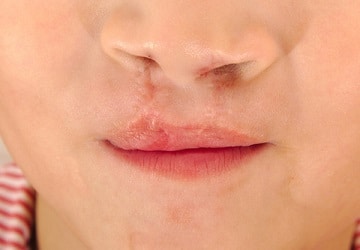
What is a cleft lip?
A cleft lip can range from a tiny notch in the upper lip to a split that extends into the nose. It can occur alone or in association with cleft palate. Cleft lip with or without palate is best treated in a team approach, with multiple specialists trained in pediatric craniofacial problems.
What causes a cleft lip?
Although much research has been done on cleft lip and palate, doctors and scientists do not completely understand why clefts occur. Likely due to a combination of genetic and environmental factors, the two sides of the lip or palate do not come together while the fetus is developing.
Some children with cleft lip and palate have other related abnormalities, but most children with clefts are otherwise healthy, normal children. Sometimes, a cleft lip is diagnosed on pre-natal ultrasound. We are happy to meet with parents prior to delivery to discuss treatment and surgical options.
How common is cleft lip?
- About 1/1500 babies are born with cleft lip. One-third have an isolated cleft lip and two-thirds have an associated cleft palate.
Are there different types of cleft lip?
- Yes, a cleft lip can occur alone, or in association with cleft palate. Less commonly, it is associated with other conditions.
- Cleft lip can be a small notch in the upper lip, or it can extend through the entire lip into the nose.
How do I feed my baby with cleft lip?
- Babies with isolated cleft lip can often breastfeed or bottle feed just like babies without cleft lip.
- Babies with associated cleft palate will require specialized bottles and speech therapy consultation to help with infant feeding.
When is a cleft lip repaired?
- Cleft lips are typically repaired around the age of 3 months.
For further information speak to one of our specialists or please visit cleftline.org.